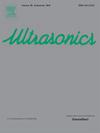Low-intensity therapeutic ultrasound effects on intracellular sodium and reactive oxygen species in ex vivo human islets for control of insulin release
IF 4.1
2区 物理与天体物理
Q1 ACOUSTICS
引用次数: 0
Abstract
Ultrasound has shown potential to non-invasively stimulate insulin release from pancreatic β-cells, but the underlying mechanisms remain poorly understood. Prior studies have suggested that mechanical effects from ultrasound, such as membrane deformation and cavitation, may play a role in modulating ion channel activity and insulin secretion. However, direct observations of intracellular signaling responses in human islets during ultrasound application are limited. In this work we investigate the effects of ultrasound on human islets in vitro using confocal fluorescence microscopy and enzyme-linked immunosorbent assay (ELISA) to measure intracellular sodium and reactive oxygen species (ROS). Human islets obtained through the NIDDK Integrated Islet Distribution Program (IIDP) were treated with ultrasound, and high glucose. Ultrasound was applied using an 800 kHz unfocused transducer for 3 min at 0.5 W/cm2 and a 16.6 % duty cycle. Fluorescence imaging showed that high glucose stimulus significantly increased intracellular sodium fluorescence (0.45 ± 0.71 A.U.) compared to ultrasound (0.03 ± 0.10 A.U.) and control (−0.012 ± 0.06 A.U.) (p = 0.001). Ultrasound also increased intracellular sodium fluorescence, though less than glucose. Reactive oxygen fluorescence measured with DCFH-DA indicated increased ROS across all conditions, with ultrasound inducing the highest increase. ELISA measures revealed high glucose caused an initial decrease in extracellular insulin (−14.36 ± 24.69 µU) followed by a moderate increase (2.2 ± 4.76 µU). Our fluorescence microscopy results indicate that high glucose treatment is causing an increase in intracellular sodium levels over the course of the fluorescence recording with that increase being significantly higher (p < 0.05) compared to ultrasound application and control. These results suggest that ultrasound stimulated insulin release does not mimic glucose-driven sodium dynamics but exert bioeffects through shorter time scale mechanical pathways. The trend of higher ROS production in the β-cell with ultrasound application compared to glucose application may suggest that ultrasound induced ROS production occurs at rates higher than physiological glucose induced levels and while ROS generation is metabolic signal in glucose induced insulin release, should be carefully considered when developing ultrasound based therapies for type 2 diabetes.
低强度治疗性超声对体外人胰岛细胞内钠和活性氧的影响,以控制胰岛素释放
超声已显示出非侵入性刺激胰腺β细胞释放胰岛素的潜力,但其潜在机制尚不清楚。先前的研究表明,超声的机械效应,如膜变形和空化,可能在调节离子通道活性和胰岛素分泌中发挥作用。然而,在超声应用过程中,人类胰岛细胞内信号反应的直接观察是有限的。在这项工作中,我们研究了超声对体外人胰岛的影响,使用共聚焦荧光显微镜和酶联免疫吸附法(ELISA)测量细胞内钠和活性氧(ROS)。通过NIDDK综合胰岛分布计划(IIDP)获得的人类胰岛用超声和高糖治疗。超声使用800 kHz无聚焦换能器在0.5 W/cm2和16.6%占空比下应用3分钟。荧光成像显示,与超声(0.03±0.10 A.U.)和对照组(- 0.012±0.06 A.U.)相比,高糖刺激显著增加细胞内钠荧光(0.45±0.71 A.U.) (p = 0.001)。超声也增加了细胞内的钠荧光,尽管比葡萄糖少。DCFH-DA测量的活性氧荧光显示,在所有条件下ROS均增加,超声诱导的增幅最大。ELISA检测结果显示,高糖引起细胞外胰岛素初始降低(- 14.36±24.69µU),随后适度升高(2.2±4.76µU)。我们的荧光显微镜结果表明,在荧光记录的过程中,高葡萄糖处理导致细胞内钠水平增加,而且增加幅度明显更高(p <;p < 0.05)。这些结果表明,超声刺激胰岛素释放并不模拟葡萄糖驱动的钠动力学,而是通过较短时间尺度的机械途径发挥生物效应。与葡萄糖应用相比,超声应用在β细胞中产生更高ROS的趋势可能表明,超声诱导的ROS产生的速率高于生理葡萄糖诱导的水平,而ROS的产生是葡萄糖诱导的胰岛素释放的代谢信号,在开发基于超声的2型糖尿病治疗时应仔细考虑。
本文章由计算机程序翻译,如有差异,请以英文原文为准。
求助全文
约1分钟内获得全文
求助全文
来源期刊

Ultrasonics
医学-核医学
CiteScore
7.60
自引率
19.00%
发文量
186
审稿时长
3.9 months
期刊介绍:
Ultrasonics is the only internationally established journal which covers the entire field of ultrasound research and technology and all its many applications. Ultrasonics contains a variety of sections to keep readers fully informed and up-to-date on the whole spectrum of research and development throughout the world. Ultrasonics publishes papers of exceptional quality and of relevance to both academia and industry. Manuscripts in which ultrasonics is a central issue and not simply an incidental tool or minor issue, are welcomed.
As well as top quality original research papers and review articles by world renowned experts, Ultrasonics also regularly features short communications, a calendar of forthcoming events and special issues dedicated to topical subjects.
 求助内容:
求助内容: 应助结果提醒方式:
应助结果提醒方式:


